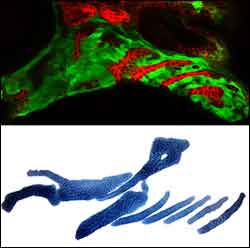Patterning the face

Vertebrates come in a dazzling array of shapes and sizes, from blue whales to pygmy bats, their overt morphology determined largely by the skeleton. The head skeleton in particular has undergone remarkable diversification, as is beautifully illustrated in Darwin’s examination of beak morphology in Galapagos finches. This week in PLoS Biology, Justin Crump, Mary Swartz, and Charles Kimmel explore the mechanism by which cell signals induce specific patterns of cartilage and bone that form the vertebrate head.
In zebrafish mutated for a gene called integrina5, the authors report, a specific region of the jaw support (hyosymplectic) cartilage fails to develop. Integrins are cell surface proteins that promote cell adhesion and signaling. Crump et al. show that Integrina5 promotes the development of an outpocketing known as the first endodermal pouch, which in turn acts as a template and helps to pattern a specific region of the hyosymplectic cartilage.
But the pouch may have more far-reaching effects. Since integrina5 mutants also have region-specific defects in cranial muscles and nerves, the first pouch may serve to organize an entire functional unit in a region of the head. As the hyosymplectic element has undergone considerable change during evolution–from a jaw-support element in fish to a tiny, sound-conducting bone called the stapes in mammals–Crump et al. speculate that such a local, interconnected strategy of development would facilitate evolution of the vertebrate head. Changes in signaling from the pouch would allow a particular skeletal element to vary in shape or size, in coordination with the muscles and nerves that move the skeletal element and independent of other regions of the head.
It will be interesting to determine, the authors note, whether this hierarchical organization applies to other skeletal elements in the head. But for now, these results will inform efforts to understand the specificity of interrelated defects seen in human craniofacial syndromes such as DiGeorge Syndrome.
Media Contact
All latest news from the category: Life Sciences and Chemistry
Articles and reports from the Life Sciences and chemistry area deal with applied and basic research into modern biology, chemistry and human medicine.
Valuable information can be found on a range of life sciences fields including bacteriology, biochemistry, bionics, bioinformatics, biophysics, biotechnology, genetics, geobotany, human biology, marine biology, microbiology, molecular biology, cellular biology, zoology, bioinorganic chemistry, microchemistry and environmental chemistry.
Newest articles

Silicon Carbide Innovation Alliance to drive industrial-scale semiconductor work
Known for its ability to withstand extreme environments and high voltages, silicon carbide (SiC) is a semiconducting material made up of silicon and carbon atoms arranged into crystals that is…

New SPECT/CT technique shows impressive biomarker identification
…offers increased access for prostate cancer patients. A novel SPECT/CT acquisition method can accurately detect radiopharmaceutical biodistribution in a convenient manner for prostate cancer patients, opening the door for more…

How 3D printers can give robots a soft touch
Soft skin coverings and touch sensors have emerged as a promising feature for robots that are both safer and more intuitive for human interaction, but they are expensive and difficult…





















